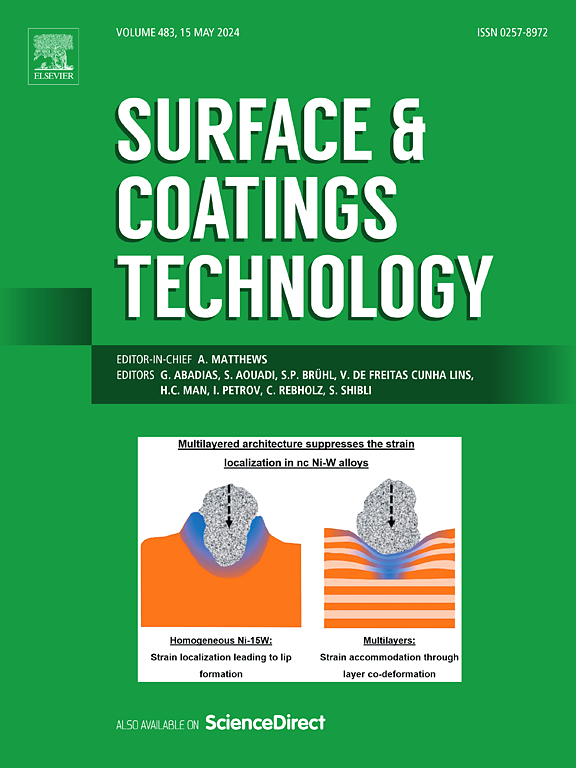超快激光制备三尺度微纳结构NdYbZr2O7熔融火山灰拒热涂层
IF 5.3
2区 材料科学
Q1 MATERIALS SCIENCE, COATINGS & FILMS
引用次数: 0
摘要
热障涂层广泛应用于发动机热截面部件,以提高其耐高温性能。在使用过程中,这些涂层经常遭受钙镁铝硅酸盐(CMAS)腐蚀。受荷叶疏水特性的启发,我们采用超快激光直写技术在TBC表面制备了三尺度的微纳网格结构,旨在提高其对熔融CMAS渗透的抵抗能力。首先,在陶瓷块上制备了不同激光扫描间距(70 μm、80 μm和90 μm)的三尺度结构。火山灰腐蚀10 min后,扫描间距为70 μm的陶瓷接触角最大,达到115°。随后,在涂层表面制备了扫描间距为70 μm的三尺度微纳结构。在火山灰暴露10分钟后,该结构表现出优越的性能,与喷涂涂层(105°)相比,具有更大的接触角(116°),并增强了抗CMAS渗透的能力。随着腐蚀时间的延长,结构涂层表面与熔融CMAS发生反应,形成由ZrO2和磷灰石相组成的反应层,抑制了进一步的渗透。激光烧蚀的微纳结构增加了表面粗糙度,与传统涂层(0.214)相比,摩擦系数(0.280)更高。本文章由计算机程序翻译,如有差异,请以英文原文为准。
Ultrafast laser fabricated triple-scale micro/nano structured NdYbZr2O7 thermal barrier coatings with molten volcanic ash repellency
Thermal barrier coatings (TBCs) are extensively applied in the hot-section components of engines to enhance their high-temperature resistance. During service, these coatings often suffer from calcium‑magnesium-alumina-silicate (CMAS) corrosion. Inspired by the hydrophobic properties of lotus leaves, we employed ultrafast laser direct writing to fabricate a triple-scale micro-nano grid structure on the TBC surface, aiming to improve its resistance to molten CMAS infiltration. First, the triple-scale structures with varying laser scanning spacings (70, 80, and 90 μm) were fabricated on ceramic bulks. After 10 min of volcanic ash corrosion, the ceramic with a scanning spacing of 70 μm exhibits the largest contact angle (115°). Subsequently, a triple-scale micro-nano structure with a scanning spacing of 70 μm was prepared on the coating surface. Following 10 min of volcanic ash exposure, this structure demonstrates superior performance, with a larger contact angle (116°) and enhances resistance to CMAS penetration compared to the as-sprayed coating (105°). With the extension of corrosion time, the structured coating surface reacts with molten CMAS and forms a reaction layer composed of ZrO2 and apatite phase, which inhibits further infiltration. The laser-ablated micro-nano structure increases surface roughness, resulting in a higher friction coefficient (0.280) compared to conventional coatings (0.214).
求助全文
通过发布文献求助,成功后即可免费获取论文全文。
去求助
来源期刊

Surface & Coatings Technology
工程技术-材料科学:膜
CiteScore
10.00
自引率
11.10%
发文量
921
审稿时长
19 days
期刊介绍:
Surface and Coatings Technology is an international archival journal publishing scientific papers on significant developments in surface and interface engineering to modify and improve the surface properties of materials for protection in demanding contact conditions or aggressive environments, or for enhanced functional performance. Contributions range from original scientific articles concerned with fundamental and applied aspects of research or direct applications of metallic, inorganic, organic and composite coatings, to invited reviews of current technology in specific areas. Papers submitted to this journal are expected to be in line with the following aspects in processes, and properties/performance:
A. Processes: Physical and chemical vapour deposition techniques, thermal and plasma spraying, surface modification by directed energy techniques such as ion, electron and laser beams, thermo-chemical treatment, wet chemical and electrochemical processes such as plating, sol-gel coating, anodization, plasma electrolytic oxidation, etc., but excluding painting.
B. Properties/performance: friction performance, wear resistance (e.g., abrasion, erosion, fretting, etc), corrosion and oxidation resistance, thermal protection, diffusion resistance, hydrophilicity/hydrophobicity, and properties relevant to smart materials behaviour and enhanced multifunctional performance for environmental, energy and medical applications, but excluding device aspects.
 求助内容:
求助内容: 应助结果提醒方式:
应助结果提醒方式:


